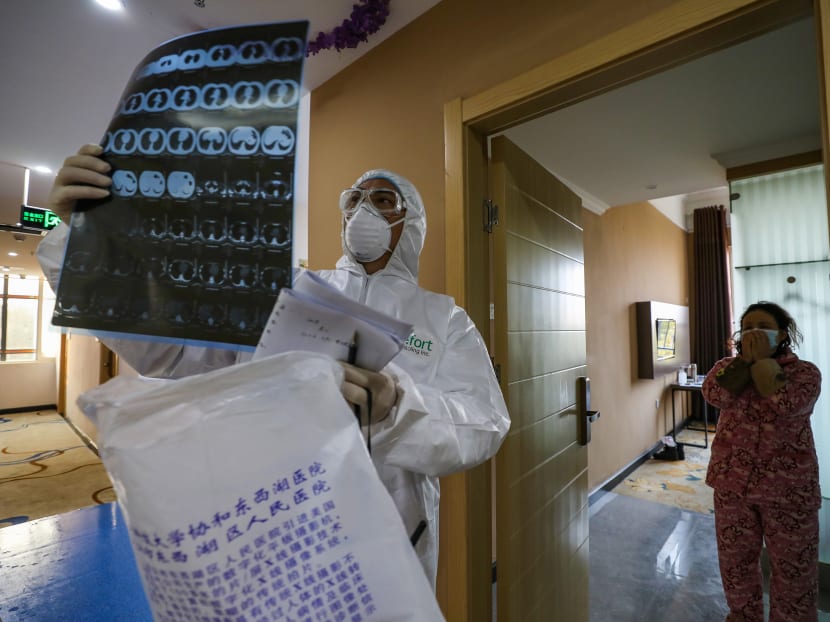Explainer: How accurate are CT scans in picking up Covid-19 and will they work in Singapore?
SINGAPORE — A new diagnostic method for the novel coronavirus, Covid-19, that relies on radiological lung scans has sent the number of confirmed cases soaring in China’s Hubei province.

This photo taken on Feb 3, 2020 shows a doctor looking at a lung CT image while making his rounds at a ward of a quarantine zone in Wuhan of China's central Hubei province.
SINGAPORE — A new diagnostic method for the novel coronavirus, Covid-19, that relies on radiological lung scans has sent the number of confirmed cases soaring in China’s Hubei province.
On Thursday (Feb 13), the number of new cases in the central Chinese province — the epicentre of the virus outbreak that began in Wuhan city — climbed by 14,840, which is a record for a single day.
The province now has more than 48,200 patients infected with the virus.
What is this new diagnostic method and why has it led to a surge in cases?
DIAGNOSIS WITH CT SCANS
Healthcare workers in Hubei have been scrambling to diagnose and treat people who may be sickened by the virus.
News agency Reuters reported previously that a shortage of kits that test the genetic signature of the virus may have brought about delays in diagnosis and treatment.
From Thursday, Hubei began using CT (computed tomography) scan results to confirm Covid-19 infections.
The province’s health commission also said that it had amended its past data and assessments of suspected patients.
Before this, Hubei relied only on RNA (ribonucleic acid) tests, which could take several days to process. This acid carries genetic information, enabling the tests to pinpoint organisms such as viruses.
Hubei’s health commission said that images from CT scans that show lung infections would speed up treatment and raise the odds of recovery. It also enables hospitals in the province to isolate patients faster.
HOW DO CT SCANS WORK?
CT scans employ a combination of X-rays and computer processing to generate cross-sectional images of the body of a patient, who is wheeled into a barrel-like scanner.
These radiological scans offer a look at almost every part of the body, and are central to diagnosing diseases and injuries as well as mapping out treatment.
HOW EFFECTIVE ARE CT SCANS IN DETECTING COVID-19?
Infectious disease experts interviewed by TODAY expressed reservations about relying on CT scans to diagnose the coronavirus.
Dr Leong Hoe Nam from the Mount Elizabeth Novena Specialist Centre said that while doctors may know how Covid-19 appears radiographically, many viruses such as the common influenza and other coronaviruses behave the same way.
“So we may be able to pick (Covid-19) up, but it still boils down to (this): Is it really… Covid-19 or something else?”
Agreeing, Dr Wong Sin Yew from the Gleneagles Medical Centre said that CT scans should not replace the more accurate RT-PCR (reverse transcriptase-polymerase chain reaction) test, which detects the presence of the coronavirus, or sequencing tests.
Dr Wong added that abnormalities seen on CT scans may have other causes, since other viruses or bacteria can cause similar changes on the scans.
Dr Leong also said that there are other disadvantages of diagnosing Covid-19 with CT scans, including:
The scans are expensive.
They expose patients to radiation.
Patients have to be transferred to CT scanners from hospital wards, for instance. There is a higher risk of contamination en route.
CT scanners must be decontaminated after each scan, requiring a massive logistical effort.
The limited availability of CT scanners.
CT scans done too early will not detect features of the virus and may generate false negatives. Conversely, when done too late, doctors may “miss the boat”.
In short, Dr Leong said that diagnosing the virus with CT scans is “challenging, fraught with risks, fraught with false negatives, and we may end up identifying a patient too late”.
However, he would use CT scans as an adjunct diagnostic tool, such as when other diagnostic tests come back negative and the doctor still suspects that a patient could be infected.
WILL CT SCANS WORK IN SINGAPORE FOR SAME PURPOSE?
Dr Leong said that the use of CT scan results in Hubei appears to be born out of desperation, as officials want to help patients as much as they can with the resources available.
“It would not happen in Singapore,” he added.
Associate Professor Hsu Li Yang, who heads the infectious diseases programme at the National University of Singapore’s Saw Swee Hock School of Public Health, said that in places such as Wuhan, where a huge outbreak is happening, the probability of lung abnormalities being caused by other viruses or bacteria is lower (though not zero).
“In a place like Singapore, however, where we have far fewer cases of Covid-19, CT abnormalities would be more likely caused by other pathogens,” he explained.
“A PCR test would be more specific at picking up cases of Covid-19 infection in our case, as well as in regions outside Hubei.”








